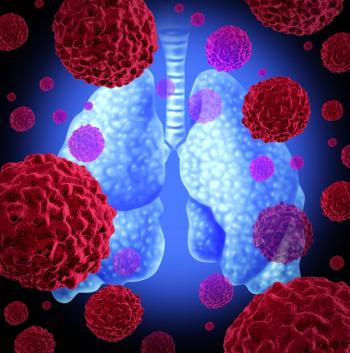
Histology… For Want of Anything Better?
Recent studies have shed new light on the role of histology in predicting sensitivity to therapeutic agents such as pemetrexed (Alimta) or bevacizumab (Avastin). Whereas during the past 30 years, the only useful histologic consideration was the absence or presence of a “non” before “small-cell lung cancer,” two US Food and Drug Administration (FDA)-approved drugs now have histologic restrictions. In this issue of ONCOLOGY, Selvaggi and Scagliotti provide an interesting review on how an old tool such as histology has recently emerged as a new criterion for treatment decisions in metastatic non–small-cell lung cancer (NSCLC). However, recent experience with tyrosine kinase inhibitors (TKIs) targeting the epidermal growth factor receptor (EGFR) demonstrate that we need to move beyond histology to improve outcomes for patients with advanced NSCLC.
Recent studies have shed new light on the role of histology in predicting sensitivity to therapeutic agents such as pemetrexed (Alimta) or bevacizumab (Avastin). Whereas during the past 30 years, the only useful histologic consideration was the absence or presence of a “non” before “small-cell lung cancer,” two US Food and Drug Administration (FDA)-approved drugs now have histologic restrictions. In this issue of ONCOLOGY, Selvaggi and Scagliotti provide an interesting review on how an old tool such as histology has recently emerged as a new criterion for treatment decisions in metastatic non–small-cell lung cancer (NSCLC). However, recent experience with tyrosine kinase inhibitors (TKIs) targeting the epidermal growth factor receptor (EGFR) demonstrate that we need to move beyond histology to improve outcomes for patients with advanced NSCLC.
Lessons From EGFR Tyrosine Kinase Inhibitors
Histology is potentially a simple tool for predicting sensitivity to a certain treatment. It is usually not used for that purpose per se, but rather, because it encompasses many different mechanisms, such as cellular, molecular, anatomic, and epidemiologic concepts. When EGFR TKIs were initially developed, it was anticipated that they would be most effective in squamous cell lung carcinoma (SCC), given the high rate of EGFR expression in this histologic subtype.[1] Further studies eventually showed that sensitivity to EGFR TKI does not correlate with EGFR expression. Indeed, the first successes of gefitinib (Iressa) were observed in patients with adenocarcinoma, which appeared to be-along with nonsmoking status, female gender, and Asian ethnicity-a clinical feature strongly associated with sensitivity to EGFR TKI. For example, among 139 patients treated with gefitinib, including 31 patients with nonadenocarcinoma tumors, the 21 patients who experienced a radiographic response all had adenocarcinoma.[2] At that time, histology could reasonably be considered a predictive factor of response to EGFR TKI.
However, a major breakthrough in patient selection was made when EGFR-activating mutations were discovered.[3,4] It appeared that the predictive value of adenocarcinoma histology was mostly due to the high rate of EGFR mutations, and was surpassed by their own predictive value. For example, in the recently published Iressa Pan-Asia Study (IPASS) evaluating gefitinib vs carboplatin and paclitaxel in first-line therapy, all patients had adenocarcinoma and were nonsmokers or former light smokers.[5] These selection criteria notwithstanding, among the 91 patients whose EGFR mutational status was known to be wild-type and who were treated with gefitinib, only one patient (1.1%) achieved an objective response, and progression-free survival was significantly shorter among patients receiving gefitinib than among those receiving chemotherapy in the mutation-negative subgroup.[5]
What About Pemetrexed and Bevacizumab?
The EGFR TKI example illustrates how histology, as a predictive factor, has been overcome and replaced by molecular analyses. Are we faced with the same situation with pemetrexed in adenocarcinoma? New insights into the mechanism of action of the drug and the key role of thymidylate synthase (TS) suggest that this may be the case.
As underscored by Selvaggi and Scagliotti, recent studies provide new evidence that TS is strongly correlated with sensitivity to pemetrexed. It has been shown that the level of TS (at either the mRNA level or the protein level) was increased in cell lines that have been made resistant to pemetrexed, compared to the parental cell lines.[6,7] Knockdown of TS using RNA interference restored sensitivity to pemetrexed.[6] Moreover, the expression level of TS was significantly correlated with the IC50 (half maximal inhibitory concentration) of pemetrexed in 11 NSCLC cell lines.[6] Given the fact that TS expression level has been found to be higher in SCC than in other histologic subtypes,[8] these results provide a body of evidence for correlating the high expression of TS with the lack of sensitivity of pemetrexed in SCC. However, further confirmation in prospective clinical studies is definitely needed prior to adopting the use of TS expression in routine clinical practice. As with EGFR inhibitors, histology may once again be supplanted by a more accurate molecular criterion as a predictive factor for pemetrexed efficacy.
Regarding bevacizumab, it is worth noting that the histologic criterion is used to predict toxicity rather than efficacy. It has not been shown that bevacizumab is inefficient in SCC. Moreover, it is not known whether the SCC histology per se accounts for the increase in hemorrhagic events, or whether it just encompasses other determining factors that have not yet been identified. Such factors could include molecular characteristics but also clinical or radiologic features. Actually, a retrospective evaluation identified baseline tumor cavitation as the only potential risk factor associated with severe pulmonary hemorrhage in first-line NSCLC treated with carboplatin and paclitaxel plus bevacizumab.[9] Cavitations have been shown to occur more often in SCC than in other histologic subtypes, either prior to any treatment or after treatment with bevacizumab.[10,11] Again, histology may only encompass a more accurate molecular predictive factor.
The Future of Light Microscopy
Both the strength and the weakness of histology is its simplicity, which makes it a tool easy to use but somehow imprecise. Rapid improvements in molecular biology techniques emphasize the limits of histology. For example, gene-expression profiling identified reproducible tumor subgroups within the adenocarcinoma histologic subtype, with distinct clinically relevant features.[12] These distinctions are not discernible with histology. Although DNA microarray platforms are still far from replacing the light microscope, efforts are needed to improve the accuracy of the histologic tool. Similarly, all of the major genomic subtypes of lung cancer, including those defined by mutations in EGFR, KRAS, BRAF, and EML4-ALK, occur in patients with adenocarcinoma. These somatic mutations occur in mutually exclusive subgroups of adenocarcinomas and have very different impacts on the efficacy of targeted therapies.[5,13,14]
Histology is one step forward. In order to jump further, we need to incorporate molecular analyses into the routine clinical treatment of patients with advanced NSCLC.
Newsletter
Stay up to date on recent advances in the multidisciplinary approach to cancer.
































































































